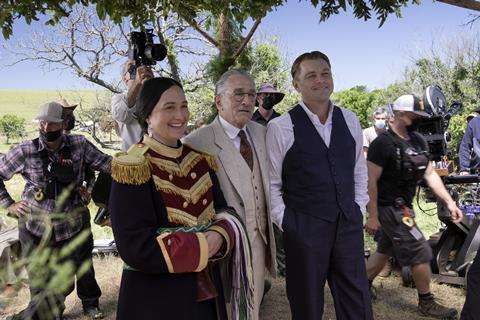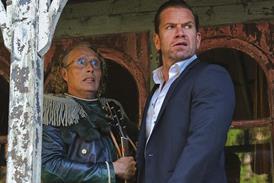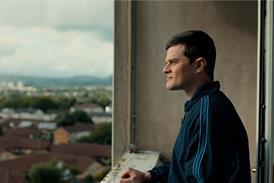Lily Gladstone tells Screen how being inspired by her great-grandmother and her own Native communities helped bring a special focus to her role in Martin Scorsese’s Killers Of The Flower Moon

Lily Gladstone has a personal memento from the set of Killers Of The Flower Moon: protagonist Mollie’s earrings. “They are the earrings I wore for most of the first act of the film, and the team gave me those.”
It remains to be seen if she will wear them on Oscar night, but for now she sports them for some of her most special moments — “When I go back and visit Osage County, I’ll wear them in that community. I wear them if I am invited to go sit on the benches with the Osage. If I’m asked to dance, I dance wearing those earrings.”
Oklahoma, and especially Osage County, are special places now for Gladstone, who lived there for the duration of the 99-day shoot of Martin Scorsese’s epic film, adapted from David Grann’s 2017 non-fiction book about how outsiders’ greed led to dozens of Osage murders in 1920s Oklahoma. Gladstone plays Mollie, a rich Osage woman, married to Ernest Burkhart (Leonardo DiCaprio) after he moves to Osage to work for his corrupt uncle (Robert De Niro).
Steeped in history

Born in Kalispell, Montana, Gladstone was raised on the Blackfeet Reservation in the northwest of the state, and is from the Blackfeet and Nez Perce Tribal Nations. She could draw inspiration from her personal family history in the way she wanted to portray Mollie. “I’m named after my great-grandmother Lily. She was born in 1896 and was a traditional Blackfoot woman who also was a very devout Catholic,” she explains. “A lot of my dad’s sense of identity was gifted to him by her. So there were a slew of family stories, the relationships that she had with her husband, who was also Native but very much like a cowboy, a fun-loving drinker — a bit like Ernest.”
Gladstone’s cultural heritage also helped in her approach to the role. “I had been raised within my community to sit and listen when elders are speaking,” she says. “I brought that into working with their community. I could bring in my own ideas but I was always checking them against what Osage had to say.”
After majoring in acting for her bachelor of fine arts degree at the University of Montana, Gladstone began her career in theatre, before making her big-screen debut in Arnaud Desplechin’s 2013 Cannes-premiering Jimmy P: Psychotherapy Of A Plains Indian, starring Benicio Del Toro and Mathieu Amalric.
But her breakout came three years later in Kelly Reichardt’s triptych Certain Women — playing a ranch hand who is drawn to a lawyer (Kristen Stewart) teaching an adult education class — which earned her nominations at the Gothams and Film Independent Spirit Awards. She appeared again for Reichardt in 2019 western First Cow, this time as wife to the community’s Chief Factor (Toby Jones). Lead roles followed in Morrisa Maltz’s The Unknown Country (SXSW 2022) and Erica Tremblay’s Fancy Dance (Sundance 2023, which was recently picked up by Apple), while on television she had roles in FX/Hulu’s Reservation Dogs and Showtime’s Billions, and is upcoming alongside Riley Keough in Hulu crime series Under The Bridge. Further film roles include The Memory Police, directed by Reed Morano, which Scorsese will executive produce.
Killers Of The Flower Moon has been a career-changing role, and Gladstone had devoured Grann’s book when it was published, but she confesses to trepidation when she read early drafts of the script (back when DiCaprio was being eyed to play FBI investigator Tom White, not Ernest). The scene she was given to audition “didn’t feel like the Mollie that I had lifted off the page in the book. It was long monologues with expository writing. So in those first auditions, I didn’t feel 100%.”
After rewrites, “suddenly it felt like the Mollie I had read in the book — three-dimensional. It didn’t feel like a paint-by-numbers where I had to stay in the lines, it was more like, ‘Here’s the palette, here’s the materials that you’re versed in, just go to town.’ There was so much space to fill in and represent Native women on screen in a way that’s rare.”
Every actor has their own way of working, and Gladstone says of DiCaprio: “We come from two different backgrounds, two different paces. Because of my work in theatre, my process is doing the building blocks beforehand, and I tend to be very internalised on set. Leo and Marty have their own process together, he’s more vocalised about it.
“I feel like my first two takes are usually best, and for Leo, we’ll try it more ways until he feels right about it,” she continues. “There was a lovely respect, never a sense of getting frustrated with each other for working at different paces or from different angles, it went into the chemistry of these characters.”
Crafting scenes

Scorsese encouraged all of Gladstone’s research and reflection with Osage women, off-screen as well as on with other Indigenous talent, some unknowns from the local community and also revered actress Tantoo Cardinal who is of Cree and Métis heritage, and who plays Mollie’s mother.
“It felt nice to lean on Marty to craft scenes so that all these Native women felt like they could have been in the golden age of cinema. Native people, especially Native women, were erased from that time period in cinema.”
The shoot took a physical toll — Mollie is being poisoned, and Gladstone needed to lose 30 pounds to represent the character at her most sick. “It was a slow elimination diet” that ramped up during a shooting pause when “I was only eating two cups of vegetables a day. It made everything more heightened for me — this fasting put me in a different space.”
The resulting Apple Original/ Paramount Pictures film — which had grossed $157m worldwide at press time — has earned Gladstone a Golden Globe, plus nominations for the Screen Actors Guild and US Academy Awards. It also won the approval of Gladstone’s father, and not just for her own performance. “It’s the first time that I’ve done a film where he said, ‘I feel like your co-star met your level. You didn’t completely outshine your co-star.’ So Leo did a good job,” she says, laughing.
Gladstone sometimes feels the weight on her shoulders as one of the industry’s most prominent Indigenous actors. “The analogy I like is that the pressure can be like water — am I going to be a dam holding all that back and feeling it all myself? Or am I going to be rocks in the river, and the water just keeps moving around? That water is healthy and has movement.”
Will that river carry her to writing or directing for the screen? “I don’t feel the compulsion that I think a lot of writers do,” she replies. “I’m haunted by the need to act the way that writers talk about being haunted by the need to write, but I go through seasons. I have written before.
“I’m pretty good at clever little one-liners,” she adds with a laugh. “I’m pretty good at structuring scenes. So at some point, I do have an intuition that I will feel that compulsion. But right now, it feels nice to, as Meryl Streep said, just act and just be an actress.”
Gladstone is not yet able to talk about her next film role, but she does say it is for someone with whom she has always dreamed of working. “Earlier in my career, people said I should avoid being pigeonholed as a Native actress because it might limit my range of characters. My counterpoint to that is Native people are everywhere. We’re doctors, we’re lawyers, we’re playing in punk bands in Australia. There are so many fascinating stories there.”















![[Clockwise from top left]: Paul Thomas Anderson, Chloe Zhao, Ryan Coogler, Park Chan-wook](https://d1nslcd7m2225b.cloudfront.net/Pictures/274x183/9/0/0/1467900_writerdirectors_192733.jpg)




![[Clockwise from top left]: Paul Thomas Anderson, Chloe Zhao, Ryan Coogler, Park Chan-wook](https://d1nslcd7m2225b.cloudfront.net/Pictures/100x67/9/0/0/1467900_writerdirectors_192733.jpg)



No comments yet